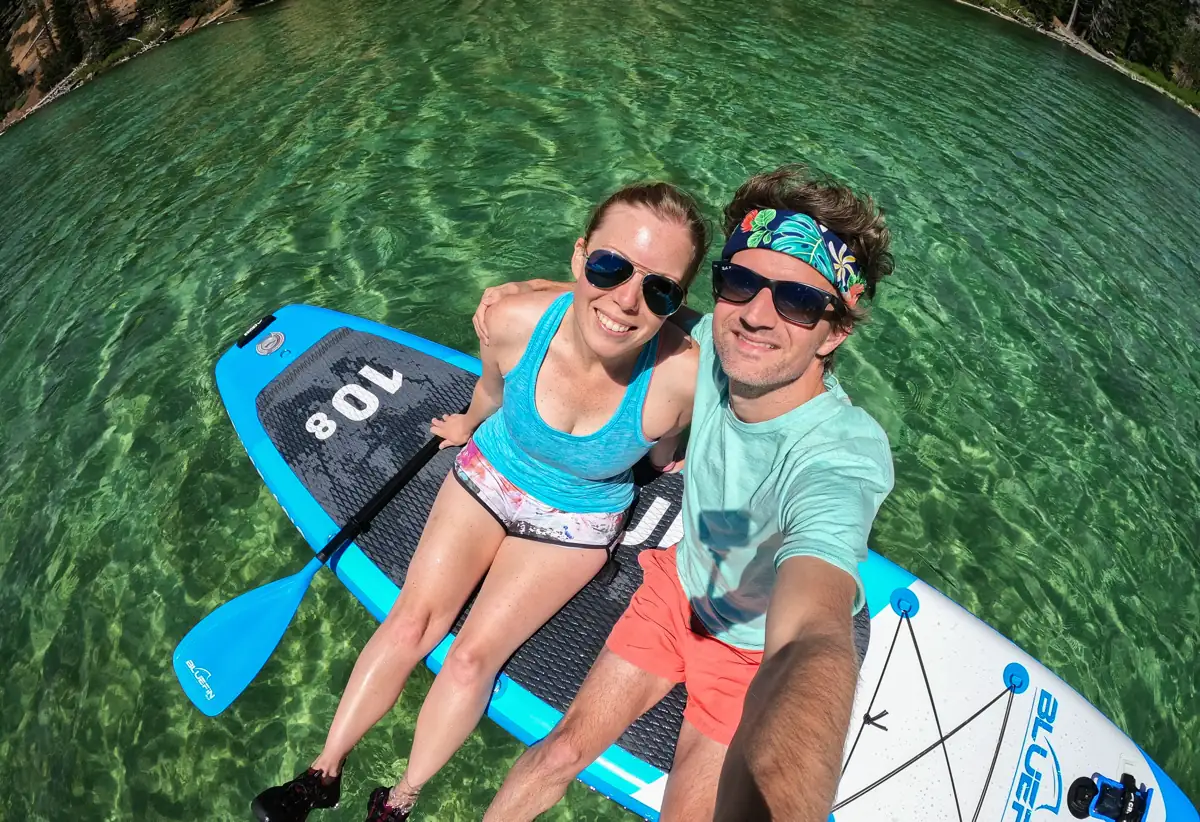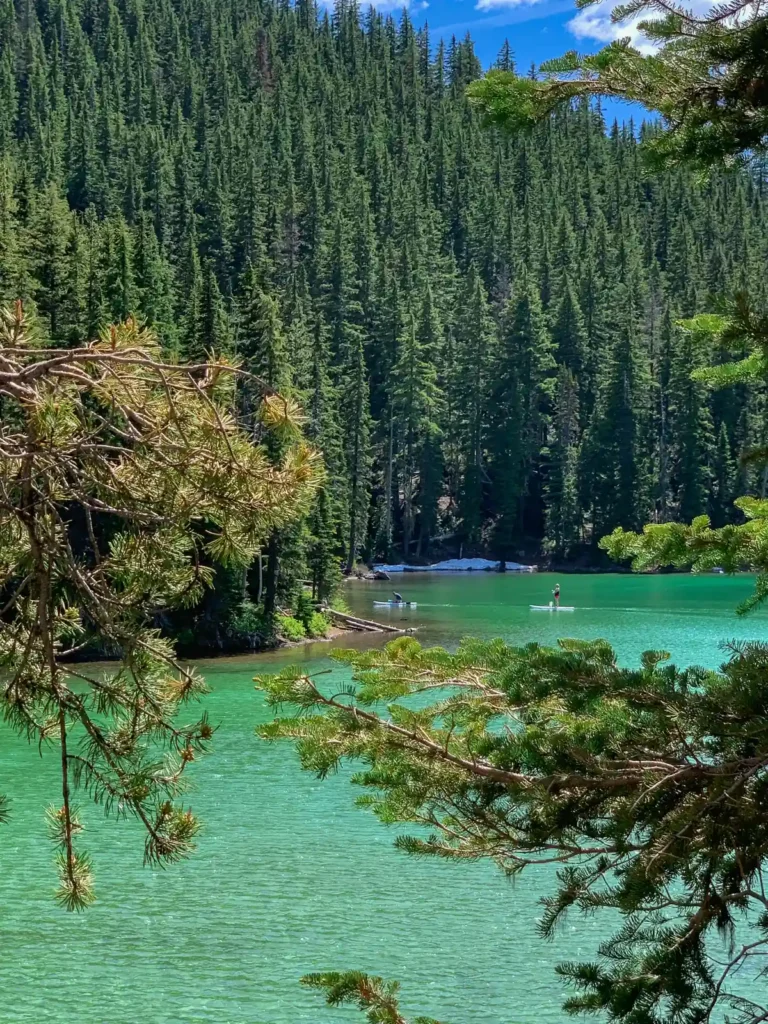Micro-adventures like stand up paddleboarding are one of the best ways to connect with nature, cool off in summer, and share unforgettable moments with your family or pup.
This guide is written for total beginners—including families with kids, dog owners, and anyone curious about trying a new activity that’s equal parts calming and adventurous.
We’ve packed this post with all the essentials: when and where to paddle, how to get started without falling in too many times, what to wear, and what to bring to make your SUP adventure a success. We’ll also point you toward our current top recommended paddle boards if you’re ready to gear up.
We’ve even included a couple of personal moments from our own SUP outings with Kepler to help bring the stoke. 🐶💦
What is stand up paddleboarding (SUP)?
Stand up paddleboarding, or SUP, is pretty much what it sounds like—standing on a wide, floaty board while you paddle across water. But it’s also so much more than that.
SUP can be peaceful or energetic, solo or social, quick or all-day-long. You can cruise across a calm lake, explore coastline coves, paddle rivers, or even surf mellow waves.
You can even do yoga on one, bring your child or dog on board, or use it to fish quietly in a lake or estuary.
For us, it’s about exploring new spots, staying active, and just soaking in the scenery—from a totally different perspective.

Why paddleboarding is the perfect summer outdoor adventure
It’s low-impact, easy to learn, doesn’t require a lot of gear, and makes hot days feel a whole lot better. If you’re someone who finds peace near water, you’re going to love being on the water.
Plus, it’s the sort of activity you can share with anyone—your kids, your friends, your parents, and your dog (yep, Kepler loves riding up front like a little sea captain).

You don’t have to be athletic or sporty to enjoy it either. Once you find your balance, it feels incredibly natural—like standing, but on water.
And the ability to explore hidden coves, alpine lakes, or river bends without needing a boat makes it feel like you’ve unlocked a secret way to travel.
When’s the best time to paddleboard?
We recommend early mornings or evenings when the wind is low, the water’s glassy, and the sun’s UV intensity is at a low level. Plus, those sunrise or sunset views are worth waking up or staying out late for.
In terms of seasons, summer is ideal for beginners, especially if you do fall in. But you can SUP in spring or fall too—just dress for the water temperature, not just the air.
Late autumn and early spring paddle sessions are stunning when the trees change color, but you’ll definitely want neoprene layers or a drysuit if you’re out in cold conditions.
Tip: always check wind speed and direction before heading out. Anything over 10mph can make things feel challenging, especially for new paddlers, it’s also just not very enjoyable.
Also avoid offshore winds that can blow you away from shore—it’s easy to paddle out and surprisingly hard to paddle back if the wind picks up.
Where to go paddleboarding
Calm water is your best friend when starting out.
Lakes, sheltered bays, and slow-moving rivers are ideal. You want somewhere that’s easy to access, has little to no boat traffic, and ideally isn’t too deep or intimidating. If there’s a gentle beach launch, even better.

Apps like AllTrails, Google Maps, or even Instagram can help you scout out good paddle spots.
And if you’ve got a water-loving dog like Kepler, check if your local lake or beach is pet-friendly so you can bring your pup along too.
Ocean paddling can be a blast—but save that for when you’re more confident. The wind, tides, and swell can add extra challenges.
We also love looking out for hidden paddling gems while on road trips—bringing an inflatable SUP along makes it really easy to explore new places spontaneously.
SUP gear for beginners (the essentials)
You don’t need much to get started, but here’s what we recommend for your first few sessions:
- A paddle board (inflatable is great for beginners and easy to store)
- Adjustable paddle (comes with most board packages)
- PFD (life vest—often legally required)
- Leash (attaches you to your board, a must for safety. Most boards come with one)
- Pump (manual or electric, for inflatables. Electric is much easier and faster)
- Dry bag (for phone, snacks, keys, extra layer)
- Water bottle (hydration matters, even when surrounded by water)
- Whistle and headlamp (required if paddling at dawn, dusk, or in low light)
🔗 Want help choosing a board? Read our guide to the best paddleboards for beginners.

Tips for your first paddleboarding experience
- Start on your knees – It’s easier to get a feel for the board before standing up.
- Stand slowly – One foot at a time, where your knees were. Keep your knees slightly bent.
- Look forward, not down – Just like trail running, sking or biking, looking ahead helps you balance.
- Use your core – Paddle from your torso, not just your arms.
- Keep your strokes close to the board – It helps you move straighter with less effort.
- Practice falling off and getting back on – It’ll boost your confidence when it happens for real.
- Stay low if the water gets choppy – Bend your knees and paddle into the chop with small strokes.
And remember, falling off is part of learning. Laugh, climb back on, and try again.
What to wear when paddleboarding
Most days you’ll be fine in a swimsuit or moisture-wicking athletic wear.
We usually throw on:
- Swimwear or boardshorts
- Rash guard or UPF shirt
- Sunglasses with a strap
- Reef-safe sunscreen
- A sunhat or cap
- Optional but highly recommended: water shoes or sandals for rocky shores
For cooler water, you might want a wetsuit or at least a thermal layer just in case you take a dip.

It’s also worth packing a quick-dry towel and some extra layers for after your paddle.
Where to rent or try a class
Local outdoor shops, lakefronts, and even REI often offer paddle board rentals and beginner lessons. If you’re not sure whether to buy one yet, trying one first is the way to go.
Many waterfront cities have rental kiosks where you can hire a SUP by the hour.
You can also rent boards at many holiday destinations—so don’t forget to pack your swimsuit when you travel.
And keep an eye out for community paddles or beginner SUP tours—they’re a great way to build confidence and meet fellow paddlers.
Final words of wisdom
You don’t need to be a water sports pro to paddleboard. Just a curious spirit, a few basics, and ideally, a warm sunny day.
Our best advice? Keep it simple. Have fun. Bring snacks. Don’t take yourself too seriously. And definitely don’t forget your towel.
This is your invitation to get outside, try something new, and make some awesome memories this summer—maybe even with your dog in tow. -Alastair ✌🏼



